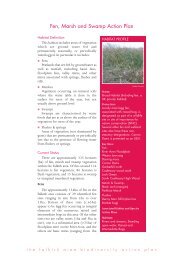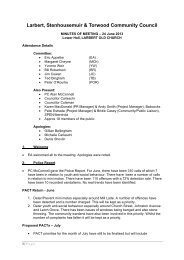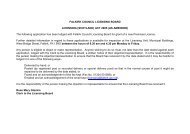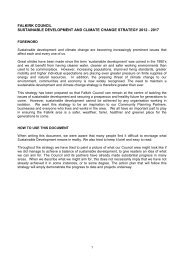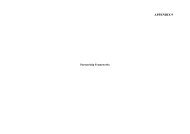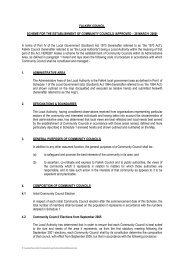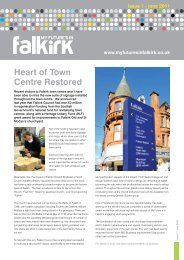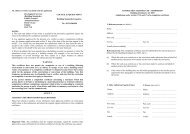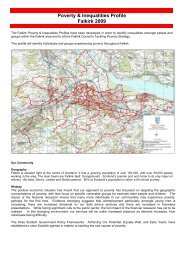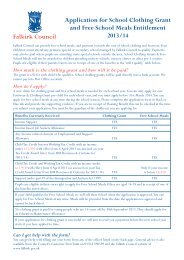2011/2012 audited annual accounts - Falkirk Council
2011/2012 audited annual accounts - Falkirk Council
2011/2012 audited annual accounts - Falkirk Council
You also want an ePaper? Increase the reach of your titles
YUMPU automatically turns print PDFs into web optimized ePapers that Google loves.
FALKIRK COUNCIL<br />
Recognition<br />
Expenditure on the acquisition, creation or enhancement of Property, Plant and Equipment is capitalised on an<br />
accruals basis, provided that it is probable that the future economic benefits or service potential associated with<br />
the item will flow to the <strong>Council</strong> and the cost of the item can be measured reliably. Expenditure that maintains<br />
but does not add to an asset’s potential to deliver future economic benefits or service potential (ie repairs and<br />
maintenance) is charged as an expense when it is incurred.<br />
Measurement<br />
Assets are initially measured at cost, comprising:<br />
• the purchase price<br />
• any costs attributable to bringing the asset to the location and condition necessary for it to be capable of<br />
operating in the manner intended by management<br />
• the initial estimate of the costs of dismantling and removing the item and restoring the site on which it is<br />
located.<br />
The <strong>Council</strong> does not capitalise borrowing costs incurred whilst assets are under construction.<br />
The cost of assets acquired other than by purchase is deemed to be its fair value, unless the acquisition does not<br />
have commercial substance (i.e. it will not lead to a variation in the cash flows of the <strong>Council</strong>). In the latter case,<br />
where an asset is acquired via an exchange, the cost of the acquisition is the carrying amount of the asset given<br />
up by the <strong>Council</strong>.<br />
Donated assets are measured initially at fair value. The difference between fair value and any consideration paid<br />
is credited to the Taxation and Non-Specific Grant Income line of the Comprehensive Income & Expenditure<br />
Statement, unless the donation has been made conditionally. Until conditions are satisfied, the gain is held in the<br />
Donated Assets Account. Where gains are credited to the Comprehensive Income & Expenditure Statement, they<br />
are reversed out of the General Fund Balance to the Capital Adjustment Account in the Movement in Reserves<br />
Statement.<br />
Assets are then carried in the Balance Sheet using the following measurement bases:<br />
• infrastructure, community asset and assets under construction – historical cost<br />
• dwellings – fair value, determined using the basis of existing use value for social housing (EUV-SH)<br />
• all other assets – fair value, determined as the amount that would be paid for the asset in its existing use<br />
(existing use value – EUV, except where there is no market based evidence of fair value).<br />
Where there is no market-based evidence of fair value because of the specialist nature of an asset, depreciated<br />
replacement cost (DRC) is used as an estimate of fair value.<br />
Where non-property assets have short useful lives or low values (or both), depreciated historical cost basis is<br />
used as a proxy for fair value.<br />
Assets included in the Balance Sheet at fair value are revalued sufficiently regularly to ensure that their carrying<br />
amount is not materially different from their fair value at the year-end, but as a minimum every five years.<br />
Increases in valuations are matched by credits to the Revaluation Reserve to recognise unrealised gains.<br />
Exceptionally, gains might be credited to the Comprehensive Income and Expenditure Statement where they<br />
arise from the reversal of a loss previously charged to a service.<br />
Where decreases in value are identified, they are accounted for by:<br />
• where there is a balance of revaluation gains for the asset in the Revaluation Reserve, the carrying amount of<br />
the asset is written down against that balance (up to the amount of the accumulated gains)<br />
• where there is no balance in the Revaluation Reserve or an insufficient balance, the excess value is written<br />
down against the relevant service line(s) in the Comprehensive Income and Expenditure Statement.<br />
The Revaluation Reserve contains revaluation gains recognised since 1 April 2007 only, the date of its formal<br />
implementation. Gains arising before that date have been consolidated into the Capital Adjustment Account.<br />
24



